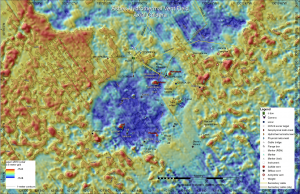ASHES Vent Field


The ASHES vent field is located ~130 m east of the caldera boundary fault. Most of the hydrothermal activity is located in an area ~ 60-80 m across, within a small depression, with only a few meters of relief. The area is floored by fractured lobate flows and some sheet flows, with pillows more common around the outer perimeter of the field. Many of the narrow fractures are diffusely venting and support tubeworms, palmworms, limpets and rare clams. The ASHES field hosts numerous small chimneys (e.g. Mushroom, Inferno, Hell, Phoenix, Virgin) that are generally small (less than ~ 4 m in height) and typically host numerous, very narrow discharge orifices (<5 cm). The edifices are commonly covered in dense macrofaunal communities that are similar to those at the diffuse flow sites, but they lack clams. Many of the chimneys have remained similar in size since the late 1980’s (Butterfield et al., 1990; Hammond, 1990). New growth forms slender, highly friable spires that are rich in anhydrite, pyrite and zinc sulfide.

Fluid temperatures and chemistry, in concert with mineralogy and vent deposit chemistry define steep chemical and thermal gradients within the walls of the actively venting edifices. Hydrothermal fluids egressing from the chimney orifices show temperatures in excess of 275°C and rapidly entrain 2°C seawater as they exit the narrow spigots. Likely due to boiling, the venting fluids are relatively particle-poor compared to many high-temperature chimneys in other vent fields (Butterfield et al., 1990). The northeastern portion of the field hosts a < 1 m tall anhydrite spire (Virgin mound) bounded by a anhydrite mound that vents clear fluids and emits some of the highest CO2-rich fluids in the caldera (Butterfield et al., 1990).
Core OOI infrastructure at ASHES is focused on examining the relationships between seismic activity and fluid flow in diffuse and black smoker sites, and how changes in diffuse fluid temperature and chemistry impacts macrofaunal communities. The main focus sites for hydrothermal flow instrumentation are adjacent to the chimneys called Mushroom and Inferno, which are located ~ 10 m apart. A network of actively venting fractures (filled with bacteria, small tube worms and limets) that radiate away from Mushroom are a hallmark of this site.

A NE-looking high definition video camera (CAMHDS301) focuses on Mushroom imaging the entire chimney every 3 hrs, twice a month 24 hrs, and once a month for 72 hrs. A long-duration osmotic fluid sampler (OSMOA301), and a three-dimensional thermistory array (TMPSFA301) are located in a small diffuse flow site near Inferno. A tight array of two short-period seismometers feeding out from this site is designed to capture local seismic events beneath the field, with the goal of defining the nature of the upflow zone beneath ASHES. Daily histograms, locations and magnitudes of seismic events at Axial are provided by W. Wilcock, University of Washington.
In 2017, a bottom pressure-tilt instrument (BOTPTA304) and CTD (CTDPFB304) were also installed as PI instruments through an NSF award to W. Chadwick, Oregon State University and daily visualizations of uplift and estimates of when Axial will erupt again are provided on his website. In 2018, a multibeam sonar system (COVIS – Cabled Observatory Vent Imaging Sonar) was installed to image diffuse and high temperature flow at Inferno, Mushroom, and associated diffuse flow sites. The sonar was installed through an NSF award to K. Bemis, Rutgers University.












